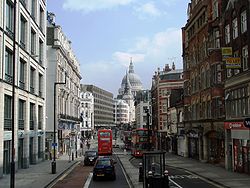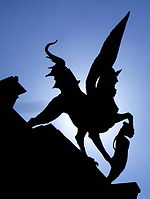
Fleet Street
Background Information
SOS Children have produced a selection of wikipedia articles for schools since 2005. SOS Children works in 45 African countries; can you help a child in Africa?
Coordinates: 51°30′51″N 0°06′32″W
Fleet Street is a street in the City of London named after the River Fleet, London's largest underground river. It was the home of British national newspapers until the 1980s. Even though the last major British news office, Reuters, left in 2005, the term Fleet Street continues to be used as a metonym for the British national press.
History and location
As early as the 13th century, it seems to have been known as Fleet Bridge Street, and in the early part of the 14th century it began to be mentioned frequently by its present name, spelled, of course, in accordance with the customs of those days. Fleet Street began as the road from the commercial City of London to the political hub of Westminster. The length of Fleet Street marks the expansion of the City in the 14th century. At the east end of the street is where the River Fleet flowed against the medieval walls of London; at the west end is the Temple Bar which marks the current City of London/ City of Westminster boundary, extended there in 1329.
To the south lies an area of legal buildings known as the Temple, formerly the property of the Knights Templar, which at its core includes two of the four Inns of Court: the Inner Temple and the Middle Temple. There are many lawyers' offices (especially barristers' chambers) in the vicinity. Nearby, on Strand, are the Royal Courts of Justice and the Central Criminal Court on Old Bailey is also only a few minutes walk from Ludgate Circus.
Publishing started in Fleet Street around 1500 when William Caxton's apprentice, Wynkyn de Worde, set up a printing shop near Shoe Lane, while at around the same time Richard Pynson set up as publisher and printer next to St. Dunstan's church. More printers and publishers followed, mainly supplying the legal trade in the four Law Inns around the area. In March 1702, London's first daily newspaper, the Daily Courant, was published in Fleet Street from premises above the White Hart Inn.
At Temple Bar to the west, as Fleet Street crosses the boundary out of the City of London, it becomes the Strand; to the east, past Ludgate Circus, the route rises as Ludgate Hill. The nearest London Underground stations are Temple, Chancery Lane, and Blackfriars tube/ mainline station, and the City Thameslink railway station.
For many years Fleet Street was especially noted for its taverns and coffeehouses. Many notable persons of literary and political fame used to frequent these, and a few, such as Ye Olde Cheshire Cheese, have survived to this day, in name at least. Along with St. Dunstan's, two other old London churches must also be mentioned as belonging to the Fleet Street region: Temple Church and St. Bride's have seen many notable processions. Wynkyn de Worde was buried in St. Bride's in 1535. In 1633, the church saw Samuel Pepys baptised.
Many famous men are associated with Fleet Street, either by living there or in one of its many side streets, or by being regular frequenters of its taverns. Amongst these include Ben Jonson, John Milton, Izaak Walton, John Dryden, Samuel Johnson, Edmund Burke, Oliver Goldsmith and Charles Lamb. One of the most successful books ever written comes from Fleet Street: in 1786 at 46 Fleet Street there was published for the first time Baron Munchausen's Narrative of his Marvellous Travels and Campaigns, written anonymously by Rudolph Erich Raspe, printed by Smith and Kearsley.
Fleet Street is also famous for the barber Sweeney Todd, traditionally said to have lived and worked in Fleet Street (he is sometimes called the 'Demon Barber of Fleet Street'). An early example of a serial killer, the character appears in various English language works starting in the mid-19th century. Neither the popular press, the Old Bailey trial records, the trade directories of the City nor the lists of the Barbers' Company mention any such person or indeed any such case.
The west part of the street was destroyed by the Great Fire of London in 1666.
The A4 road historically began at Ludgate Circus and the whole of Fleet Street was part of the route. However the A4 today begins at Holborn Circus, runs down Fetter Lane and then the western part of Fleet Street. It then continues west into Westminster.
Contemporary Fleet Street
Fleet Street is now more associated with the law and its Inns of Court and barristers' chambers, many of which are down alleys and around courtyards off Fleet Street itself, almost all of the newspapers thereabouts having moved east to Wapping and Canary Wharf. The former offices of The Daily Telegraph, drawn upon as a source by Evelyn Waugh in his comic novel Scoop, are now the London headquarters of the investment bank Goldman Sachs. C. Hoare & Co, England's oldest privately owned bank, has had its place of business here since 1690. An informal measure of City takeover business employed by financial editors is the number of taxis waiting outside such law firms as Freshfields at 11pm: a long line is held to suggest a large number of mergers and acquisitions in progress.
The London office of D.C. Thomson & Co., creator of The Beano, is still based on Fleet Street. The Secretariat of the Commonwealth Broadcasting Association is also an important Fleet Street address, at number 17. Since 1995 Fleet Street has been the home of Wentworth Publishing, an independent publisher of newsletters and courses. In 2006 the Press Gazette returned to Fleet Street, albeit only briefly. The Associated Press and The Jewish Chronicle remain close by. The Daily Telegraph and Sunday Telegraph have recently returned to the centre of London after having been downriver in Canary Wharf, but have not returned to Fleet Street.
St Bride's Church, just off the eastern end of Fleet Street, remains the London church most associated with the print industry. A plaque in the church records the vigils held for journalists held hostage in Lebanon in the 1980s and 1990s, including John McCarthy and Terry Anderson. In the adjacent St. Brides Lane is the St Bride Library, specialising in the type and print industry.
Several other news or publishing-related organisations are clustered on or close to Fleet Street. The British Association of Journalists is based at 89 Fleet Street; the Newspaper Society is nearby on St. Andrew Street; KM Group is at 75 Shoe Lane; and at number 76 is the London International Press Centre, home to TradeWinds, the international shipping news magazine, the Cartoonists' Club, and the International Broadcasting Convention. Metro International, publishers of the free newspaper Metro, are at 85 Fleet Street, while Meteor Press is at number 17.
Other related businesses near Fleet Street include The Wall Street Journal in Fleet Place, the New Law Journal, the Perseus Books Group, Bowker UK, Motor Cycle News, the Worshipful Company of Stationers and Newspaper Makers, and the London Press Club.
On the wall of Magpie Alley, off Bouverie Street, is a huge mural depicting the history of newspapers in the area.
Fiction and drama about Fleet Street
- George King: Sweeney Todd: The Demon Barber of Fleet Street (1936 film) and the Tim Burton adaptation of the Stephen Sondheim musical Sweeney Todd: The Demon Barber of Fleet Street (2007 film).
- A. N. Wilson: My Name is Legion (2003).
- Amanda Craig: A Vicious Circle (1996) (about a fictitious British newspaper tycoon and the world of publishing in general).
- Michael Wall: Amongst Barbarians (1989) (Similar to Lily d'Abo in My Name Is Legion, a white British working class couple takes money from a tabloid in order to be able to help their son).
- Howard Brenton and David Hare: Pravda (1985) (about a Rupert Murdoch-like character).
- A. N. Wilson: Scandal (1985) (About how a political scandal is created by the tabloid press).
- Michael Frayn: Towards the End of the Morning (1967) (a comic novel about failed and failing journalists in a 1960s newspaper)
- Evelyn Waugh: Scoop (1938) (about a thinly disguised British Newspaper, The Daily Beast, and one of its contributors who is sent to an African country at war called Ishmaelia, based upon the author's experiences in Abyssinia)
- Pete Townshend: " Street in the City" (song)
- The Day The Earth Caught Fire: A 1961 science fiction film, starring Janet Munro and Leo McKern where concurrent Russian and U.S. nuclear tests alter the Earth's orbit, sending it spinning towards the Sun. Much of the impending disaster is seen from the perspective of staff at the Fleet Street office of the Daily Express.
- John Davidson: Fleet Street Eclogues (1893) and A Second Series of Fleet Street Eclogues (1896).
- Charles Dickens: A Tale of Two Cities: (Setting of the Tellson's Bank is on Fleet Street).
- Charles Dickens: The Posthumous Papers of the Pickwick Club, more commonly known as The Pickwick Papers (talks about the journalism on Fleet Street).
- The opening sequence of Children of Men is set on Fleet Street. The protagonist, portrayed by Clive Owen, leaves a café which then explodes in an act of terrorism.
Michael Molloy: The Century (1990)
Non-fiction
- Nick Davies: Flat Earth News (2008).
- Peter Paterson Much More of This, Old Boy...? Scenes From a Reporter's Life (2011)
- Fritz Spiegl: Keep Taking the Tabloids. What the Papers Say and How They Say It (1983).
- A. N. Wilson: London: A Short History (2004).
- Alan Watkins: A Short Walk Down Fleet Street.
- Linda Melvern: "The End of the Street" (1986).





